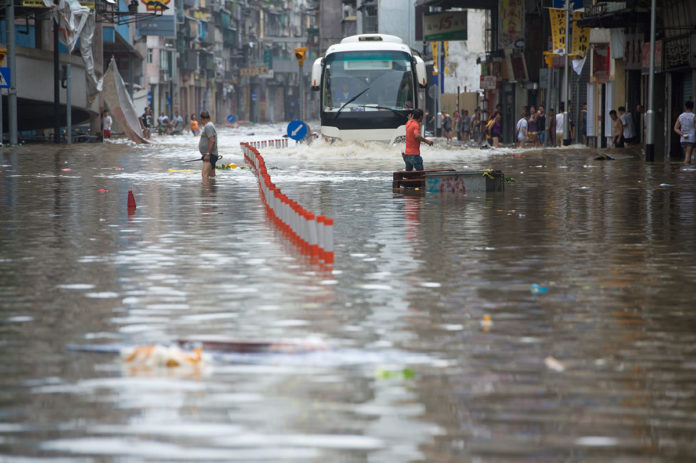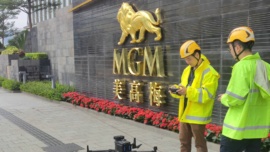“From a statistical point of view, such an extreme event [like Hato] will happen again,” researcher Yu Qiwei – lead author of Human damage assessments of coastal flooding for Hong Kong and the Pearl River Delta due to climate change-related sea level rises in the twenty-first century, published two months ago – told Macau Business
“Our results suggest that a region’s flood vulnerability is partly related to its level of socioeconomic development. The PRD region, which is less developed than Hong Kong, is more vulnerable to human costs (death and displacement). With a rising sea level, the probability of extreme coastal flood disasters of high magnitude will increase significantly” we can read in the paper published in scientific magazine Natural Hazards.
From their statistical models, Qiwei and his team have concluded that “in the absence of proper protection and adaptation, potential losses can be very high. For example, with a Sea Level Rise (SLR) of 75 cm by 2100 the annual average loss in Hong Kong will lead to more than 20 deaths, 100,000 people displacements. In the PRD region, it will result in more than 200 deaths, 1.5 million people displacements.”
And what example does the team led by the young researcher from Hong Kong University of Science and Technology use?
“Severe Typhoon Hato in 2017 is a painful lesson which caused serious flooding in this region (Hong Kong, Macau and Zhuhai), with outages of water and citywide power in Zhuhai and Macau. The cross-boundary risks shall be properly and effectively dealt with by the region flood management plan. It is critical for Hong Kong and the PRD cities to take flood risks more seriously and work on climate adaptation and resilience planning to make sure that the region’s essential services can readily recover after a severe regional storm surge event.”
Interviewed by Macau Business, Qiwei Yu states: “We cannot guess what will happen again but if we can adapt to the risk properly (e.g.) warning systems, people staying at home, recovery systems, the damage could be lessened . . . [even though] . . . the Pearl River Delta is located in a low-lying region, the elevation of a large area of the PRD region is below 2m. In this region, both GDP per capita and population density are high, which means if extreme weather hits this region like Hato both economic and human loss will be significant.”
The issue is therefore not easy to resolve.
On the one hand, climate change does not depend (only) upon what a country or a region can do to combat or mitigate it. On the other hand, mitigating measures are not easy to implement – just look at the example of Macau.
 “Against a background of climate change, Macau is very exposed to SLR because of its low elevation, small size and ongoing land reclamation,” claims Chinese expert Gang Huang, author of the most comprehensive study on the consequences of SLR in Macau.
“Against a background of climate change, Macau is very exposed to SLR because of its low elevation, small size and ongoing land reclamation,” claims Chinese expert Gang Huang, author of the most comprehensive study on the consequences of SLR in Macau.
The warnings of Mr. Gang Huang, published in 2015, cannot leave anyone indifferent, particularly those administering Macau:
“Generally, the rise of sea level [will] not only have tremendous impact upon Macau but [will] affect any coastal lowland,” he maintains. “Nevertheless, compared to other port cities along the coastal margins of China, Macau is most susceptible to SLR-induced hazards. On the one hand, because of limited land areas, the landward migration of coastal assets and communities will be much more constrained. On the other hand, Macau has the largest land reclamation programmes in China, which in turn exacerbates the threats from SLR.”
According to this researcher from the Institute of Atmospheric Physics, Chinese Academy of Sciences, Beijing, “the sea level in Macau is now rising at an accelerated rate: 1.35 mm/yr. 1 from 1925–2010 and jumping to 4.2 mm/y. 1 from 1970–2010, which outpaces the rise in global mean sea level. In the future, the rate of SLR in Macau will be about 20% higher than the global average as a consequence of a greater local warming tendency and strengthened northward winds.”
Qiwei Yu highlights efforts made in Guangdong Province and Hong Kong, saying: “In recent years, various governmental departments [have been] involved in flood management in Hong Kong with building water infrastructure and public awareness, especially for the low-lying flood-prone area in Tai O.
“Furthermore, HKO continuously improves tropical cyclone forecasting and provides warning services. With these actions, the total number of deaths posed by tropical cyclones in Hong Kong is significantly declining,” he told Macau Business.
And in Macau?
It is known that an interdepartmental working group was created to deal with the subject but little or nothing is known about what has been done in these three years. Macau Business contacted, via Macau Environmental Protection Bureau, an individual who is one of the highest local authorities in the matter, Kampeng Lei, but the answer could not be more empty.
“In the absence of proper protection and adaptation, potential losses can be very high. For example, with a Sea Level Rise of 75 cm by 2100 the annual average loss in Hong Kong will lead to more than 20 deaths, 100,000 people displacements. In the PRD region, it will result in more than 200 deaths, 1.5 million people displacements” – Qiwei Yu
“In response to global climate change, the MSAR Government set up an Interdepartmental Working Group on Climate Change in 2015 to implement the climate change mitigation obligations of the UN Framework Convention on Climate Change and the Kyoto Protocol,” he says. “The Working Group is co-ordinated by the Directorate of Meteorological and Geophysical Services, with the Environmental Protection Bureau one of its members. Therefore, this service directorate is committed to co-ordinating the work of the Working Group to co-operate with climate change.”
Meanwhile, the former Executive Secretary for the United Nations Framework Convention on Climate Change, Christiana Figueres, told Macau News Agency this year: “There is a high level of certainty that typhoons hitting Macau and Asia in general will increase in frequency and intensity because the increase in [global] temperature leads to an increase in air humidity, leading to more typhoons,”
The Macau Government seems to agree: “Due to climate change, this kind of radical storm can happen more often,” said Government Spokesman Victor Chan a few days after Hato struck. If everything is out of control and we cannot respond we will remove the population,”
Blame the people
“When you get Signal 8, people play Mahjong. They like to have a typhoon to stay at home to rest and not have to go to school. There are people who even go for a walk, even in the rain and strong wind,” said Secretary for Security Wong Sio Chak in November. “Sai Van Bridge is only for transportation and emergency vehicles, but we see a lot of people on stormy days crossing it,”
























